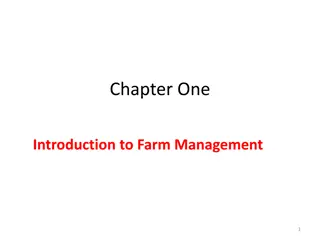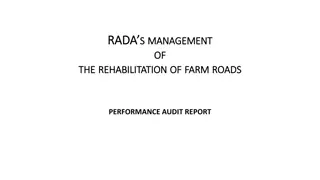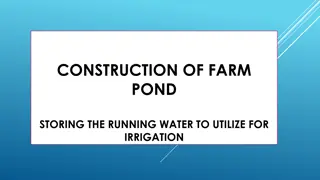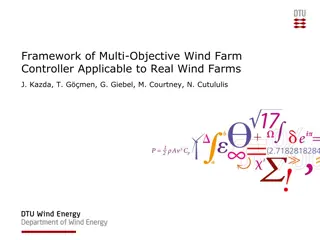Overview of Farm Power Sources and Utilization in Agriculture
Farm power sources in agriculture include human, animal, mechanical, and renewable energy. Human power is costly but versatile, while animal power is traditional and provides manure. Mechanical power from tractors and engines is efficient. India's farm power sources reflect a mix of traditional and modern technologies, with a significant reliance on human and animal power despite the presence of mechanical and electrical options.
Download Presentation

Please find below an Image/Link to download the presentation.
The content on the website is provided AS IS for your information and personal use only. It may not be sold, licensed, or shared on other websites without obtaining consent from the author. Download presentation by click this link. If you encounter any issues during the download, it is possible that the publisher has removed the file from their server.
E N D
Presentation Transcript
STUDY OF SOURCES OF FARM POWER Class-1
INTRODUCTION A farm power for various agricultural operations can be broadly classified as: (1) Tractive work such as seed bed preparation, cultivation, harvesting and transportation, and (2) Stationary work like silage cutting, feed grinding, threshing, winnowing and lifting of irrigation water. These operations are done by different sources of power, namely human, animal, oil engine, tractor, power tiller, electricity and renewable energy (biogas, solar and wind).
Farm Power in India Indian is the highest producer of tractor in the world with annual production of 548397 tractors(2010-11) Total population of tractor is about 4.0 million Annual sale of power tillers in India is about 35000 Total population of power tiller in India is about 3 lakh. Diesel engine population 76 lakh Electric motor population 12 million. Out of 342 m workforce 224 m(66%) are agril. Workers. Draft animals are 74 million Average land holding is 1.6 ha (India) and 1.25 ha (Odisha). 67% land area is rainfed 3
Sources of Farm Power Human Power Animal Power Mechanical Power Tractors Power tillers Self Propelled combines Oil Engines Diesel Engine Petrol/Kerosene engine Electric Power Renewable energy o o 4
Human Power 224 million agricultural workers out of total 342 million workers Contribution of power is only 5.09 % of the total power Most important source of power for operating small implements and tools. On an average a man can develop 0.1 hp Advantages Easily available Used for all types of work Disadvantages Costliest source of power Very low efficiency Requires full maintenance when not in use Affected by weather condition and season. 5
Animal Power 71million animals in India Contribution of draft animals is 6.37 per cent Employed for mostly tractive work but can be employed for all types of work. On an average a pair of bullock can develop 1 hp Other animals like buffalo, camel, horse, donkey, mule and elephant are also used for farm work. Advantages Easily available Used for all types of work Low initial investment Supplies manures to field and fuel to farmers Lives on farm produce Disadvantages Not very efficient Season and weather affect efficiency High over load capacity Can not work at a stretch Requires full maintenance when not in use 6
Mechanical Power Tractors, Power Tillers, Oil Engines and P Engines are the main source of mechanical power Population of tractor, power tiller and Diesel engine in India is about 40, 3 and 76 lakhs, respectively. Contribution of tractor and power tiller is about 51.08 %, stationery engine contributes 37.46 per cent. (Total contribution of non-animate power is 88.54 per cent) Advantages Efficiency high Not affected by weather Requires less space Cheaper form of power Disadvantages Initial investment is high. Does not require full maintenance when not in use 7
TRACTOR Tractors are available in following classes, depending upon Hp. 20-30 hp(About 25% of total production in India) 31-40 hp(About 60% of total production in India) 41 and above (About 15% of total production in India) Tractor production started in India in 1961 The first tractor manufacturer , M/S Eicher Good earth at Faridabad. Average command area of a tractor (26.1kw)/35hp is about 15 hectares.
POWER TILLER Power range of power tiller 5.97 to 8.95kw(8 to 12 hp) Average command area of power tiller is 5 hectares. One pair of bullock have the command area of 1 hector.
OIL ENGINE The oil engine is a highly efficient device for converting fuel into useful work. The efficiency of diesel engine varies between 32 and 38 per cent, whereas that of the carburetor engine is in the range of 25 and 32 per cent. In recent years, diesel engines and tractors have gained considerable popularity in agricultural operations. Small pumping sets within 3 to 10 hp range are very much in demand. Likewise, oil engines of low to medium speed developing about 14 to 20 hp are successfully used for flourmills, oil ghanis, cotton gins, etc. Diesel engines of the larger size are used on tractors.
Electrical Power Electrical power mostly used in farm in the form of electrical motors. Used for lifting water, running stationery machines, diary, processing, poultry farms. About 12 million electric motors in use in Indian agriculture. Advantages o Clean, quiet and cheap source of power o High efficiency o Can work at a stretch o Maintenance and operating cost is very low. o Not affected by season. Disadvantages Initial invetsment is high Requires good technical knowledge 11
Renewable Energy Mainly bio-energy, wing energy and solar energy are suitable for Indian agriculture. Used for water lifting, drying, lighting, water heating, food processing, domestic use, engine operation and electricity generation. Advantages oNo atmospheric pollution oInexhaustible in nature Disadvantages Seasonal in nature Location specific. Low efficiency 12























